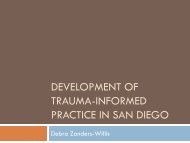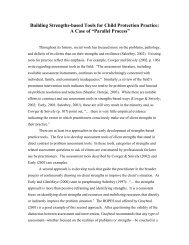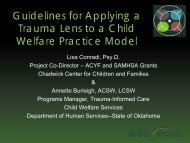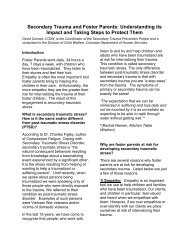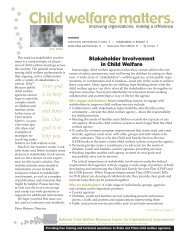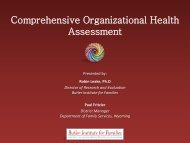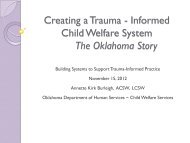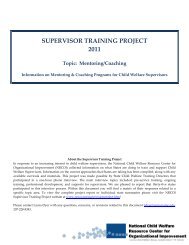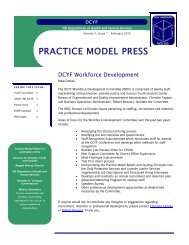Secondary Trauma and Child Welfare Staff: Understanding its ...
Secondary Trauma and Child Welfare Staff: Understanding its ...
Secondary Trauma and Child Welfare Staff: Understanding its ...
Create successful ePaper yourself
Turn your PDF publications into a flip-book with our unique Google optimized e-Paper software.
ecause of their desire to help children<br />
<strong>and</strong> families. Empathy, or identifying<br />
with <strong>and</strong> underst<strong>and</strong>ing another’s<br />
situation <strong>and</strong> feelings, is one of the most<br />
effective tools to use when working with<br />
children <strong>and</strong> families. Unfortunately,<br />
when caseworkers “over-identify” with<br />
their clients (which can easily happen)<br />
they elevate their risk for internalizing<br />
their trauma.<br />
2) Insufficient Recovery Time:<br />
Caseworkers have frequent contact with<br />
abused <strong>and</strong> neglected children. They<br />
hear their stories <strong>and</strong> feel their pain.<br />
Unfortunately, caseworkers’ heavy <strong>and</strong><br />
dem<strong>and</strong>ing workload can deprive them<br />
of the “time-off” they need to heal <strong>and</strong><br />
recover from what they have heard <strong>and</strong><br />
seen.<br />
3) Unresolved Personal <strong>Trauma</strong>:<br />
Many caseworkers have had some<br />
personal loss or even traumatic<br />
experience in their own life (e.g., loss of<br />
a family member, death of a close<br />
friend, physical or emotional abuse).<br />
The pain of their own experience(s) may<br />
be "re-activated" when they hear the<br />
child describe a traumatic situation<br />
similar to the one they experienced.<br />
Unless the caseworker has healed from<br />
her/his own trauma they are at<br />
increased risk for internalizing the<br />
trauma of their clients.<br />
4) <strong>Child</strong>ren are the Most Vulnerable<br />
Members of Our Society: Young<br />
children are completely dependent on<br />
adults to meet their emotional <strong>and</strong><br />
physical needs. When adults maltreat<br />
children, it is especially painful for<br />
caseworkers whose chosen career is to<br />
protect children. Their resulting feelings<br />
of sadness <strong>and</strong> helplessness place<br />
them at elevated risk for being<br />
secondarily traumatized (Figley, 1995).<br />
5) <strong>Secondary</strong> <strong>Trauma</strong> is cumulative:<br />
Contrary to popular belief it is not just<br />
the horrendous cases of abuse, like<br />
child deaths or serious injuries, that are<br />
secondarily traumatizing for<br />
caseworkers. <strong>Secondary</strong> trauma is<br />
cumulative. Even the small things, like<br />
seeing sadness in a child’s eyes when a<br />
home visit ends, can be traumatizing for<br />
a caseworker. Witnessing these events<br />
over <strong>and</strong> over again can have a<br />
negative effect on even the most<br />
compassionate <strong>and</strong> resilient<br />
caseworkers.<br />
How do you know if you are suffering<br />
from secondary traumatic stress?<br />
One of the most difficult tasks for a<br />
caseworker is to recognize <strong>and</strong><br />
acknowledge that they are suffering<br />
from secondary traumatic stress. Every<br />
person reacts differently <strong>and</strong> copes<br />
differently with their reaction to<br />
adversity. What one person finds<br />
helpful may not be helpful for another<br />
person <strong>and</strong> vice versa. During difficult<br />
times, all people must remember to call<br />
on the coping mechanisms that work<br />
best for them. There are, however,<br />
several "individual indicators of distress"<br />
which can tell us that we are at<br />
increased risk for developing secondary<br />
trauma. A key indicator is when you find<br />
yourself acting <strong>and</strong> feeling in ways that<br />
don’t feel normal to you. It is normal for<br />
all of us to have a range of emotions<br />
that include anger, sadness, depression<br />
or anxiety. However, when these<br />
emotions become more extreme or<br />
prolonged than usual, it is a potential<br />
indicator of distress (see table below).<br />
When you begin to see or feel, in<br />
yourself, emotional or physical<br />
indicators of extreme distress, it is time<br />
to step back <strong>and</strong> evaluate yourself. Are



